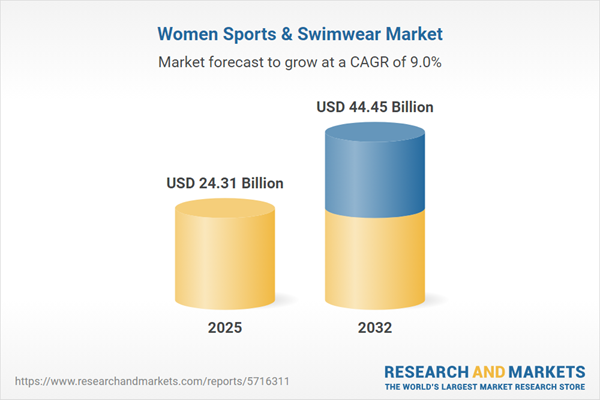Speak directly to the analyst to clarify any post sales queries you may have.
Senior leaders in the women’s sportswear and swimwear industry face ongoing transformation fueled by shifting consumer expectations, new technologies, and heightened sustainability requirements. Strategic intelligence is paramount to navigate complexity and accelerate organizational growth in this evolving market landscape.
Market Snapshot: Women’s Sportswear and Swimwear Market Size and Growth
The global women’s sportswear and swimwear market is valued at USD 22.29 billion in 2024, forecast to reach USD 44.45 billion by 2032, with a projected compound annual growth rate (CAGR) of 9%. This expansion is propelled by rising consumer focus on health, the widespread adoption of athleisure apparel, and the accelerated shift toward digital retail. Market players are optimizing supply chain models to enhance flexibility, emphasizing strategic innovation and sustainability practices to strengthen their market position and outpace evolving competition.
Scope & Strategic Segmentation in the Women’s Sportswear and Swimwear Market
This report equips senior decision-makers with actionable segmentation and comprehensive insights to analyze emerging trends and identify growth catalysts. Each segment delivers frameworks for building resilient, tailored strategies across the evolving B2B apparel ecosystem.
- Product Types: Bikinis, one-piece suits, swimdresses, and tankinis cater to a variety of consumer needs. Brands focus on advanced designs, ergonomic comfort, and enhanced technical features to address functionality and style requirements.
- Distribution Channels: Direct-to-consumer models, e-commerce, hypermarkets, specialty outlets, supermarkets, and niche retail platforms expand access, enabling brands to extend reach and improve proximity to key customers.
- Price Tiers: A spectrum spanning value to premium segments supports targeted pricing strategies. This enables companies to maximize exposure, address multiple audience segments, and protect category-wide profitability.
- Sport Types: Product innovation addresses both recreational and professional needs, with development emphasizing advanced textiles that support a wide range of athletic and leisure activities.
- Material Innovation: Advances in nylon, polyester, spandex-elastane, and eco-friendly materials highlight the value of durability and environmental responsibility within the product pipeline.
- Age Groups: Market offerings are segmented for young adult to mature demographics, providing critical guidance for age-appropriate design, sizing, and targeted communications strategies.
- Regional Analysis: Coverage includes Americas, Europe, Middle East & Africa, and Asia-Pacific regions. This framework provides executives with regulatory and cultural insight to underpin regionally nuanced strategies.
- Key Industry Players: Major brands—Nike, adidas, Puma, Lululemon, Anta Sports, Under Armour, ASICS, Speedo, Arena, and Victoria’s Secret—provide benchmarking and open pathways for partnership assessment in a competitive environment.
Key Takeaways for Executive Leaders
- Adopting digital-centric and omnichannel retail strategies increases engagement by seamlessly integrating physical and online experiences, positioning brands for competitive differentiation.
- Prioritizing sustainable sourcing and environmentally responsible product design strengthens compliance and elevates brand value among markets with high sustainability expectations.
- Strategic collaboration with influencers and community stakeholders enhances brand credibility and deepens trust with target audiences.
- Developing organizational agility allows companies to swiftly respond to fluctuations in consumer preferences and lifestyle trends, supporting business resilience.
- Integrating real-time analytics into logistics and supply operations boosts inventory responsiveness and accelerates decision-making for dynamic market conditions.
- Localizing strategies for distinct regions supports adaptive growth by addressing specific regulatory, cultural, and consumer requirements.
Tariff Impact on Supply Chains and Pricing
With anticipated U.S. tariffs in 2025, organizations in the women’s sportswear and swimwear market are reassessing global sourcing portfolios. Moving toward regional and nearshore suppliers helps mitigate cost volatility and regulatory uncertainty. Flexible pricing strategies, coupled with ongoing monitoring of supply networks, increase the capacity to adapt efficiently as trade dynamics change.
Methodology & Data Sources
Research for this analysis integrates firsthand data from expert interviews, stakeholder engagement, and focused group sessions. All information is independently validated through third-party sources to ensure accuracy for informed executive decision-making in the women’s sportswear and swimwear market.
Why This Report Matters for Senior Executives
- Offers clear, actionable insights driven by robust market analysis for strategic planning and decision-making across the apparel sector.
- Delivers granular segmentation and supply chain perspectives to guide diversification and strengthen product portfolio agility for senior leadership.
- Enhances risk management and organizational adaptability for successfully navigating regulatory, regional, and industry-wide shifts.
Conclusion
This report provides senior executives with the tools and segmentation clarity to address industry complexity, optimize competitive strategies, and support sustainable growth across the global women’s sportswear and swimwear markets.
Additional Product Information:
- Purchase of this report includes 1 year online access with quarterly updates.
- This report can be updated on request. Please contact our Customer Experience team using the Ask a Question widget on our website.
Table of Contents
3. Executive Summary
4. Market Overview
7. Cumulative Impact of Artificial Intelligence 2025
Companies Mentioned
The companies profiled in this Women's Sports & Swimwear market report include:- Nike, Inc.
- adidas AG
- Puma SE
- Lululemon Athletica Inc.
- Anta Sports Products Limited
- Under Armour, Inc.
- ASICS Corporation
- Speedo International Ltd.
- Arena S.p.A.
- Victoria’s Secret & Co.
Table Information
| Report Attribute | Details |
|---|---|
| No. of Pages | 187 |
| Published | October 2025 |
| Forecast Period | 2025 - 2032 |
| Estimated Market Value ( USD | $ 24.31 Billion |
| Forecasted Market Value ( USD | $ 44.45 Billion |
| Compound Annual Growth Rate | 9.0% |
| Regions Covered | Global |
| No. of Companies Mentioned | 11 |









